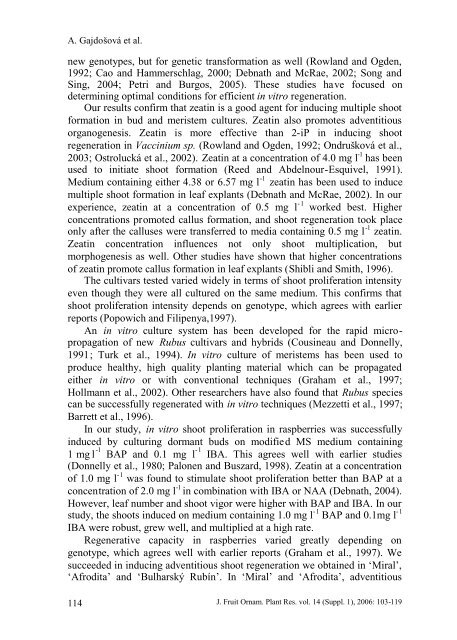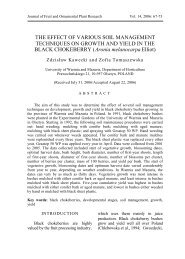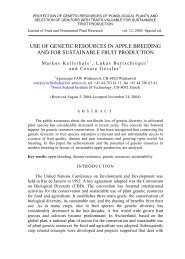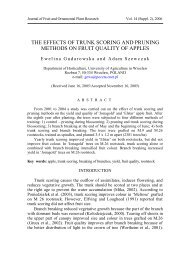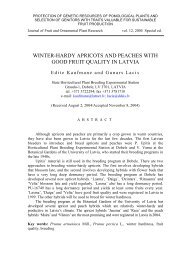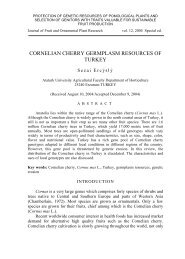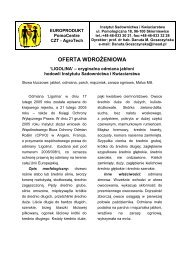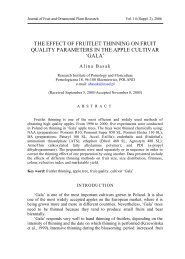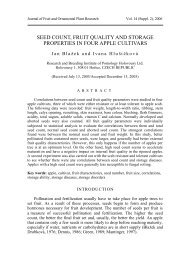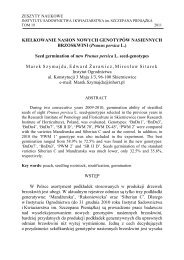MICROCLONAL PROPAGATION OF Vaccinium SP. AND Rubus SP ...
MICROCLONAL PROPAGATION OF Vaccinium SP. AND Rubus SP ...
MICROCLONAL PROPAGATION OF Vaccinium SP. AND Rubus SP ...
You also want an ePaper? Increase the reach of your titles
YUMPU automatically turns print PDFs into web optimized ePapers that Google loves.
A. Gajdošová et al.new genotypes, but for genetic transformation as well (Rowland and Ogden,1992; Cao and Hammerschlag, 2000; Debnath and McRae, 2002; Song andSing, 2004; Petri and Burgos, 2005). These studies have focused ondetermining optimal conditions for efficient in vitro regeneration.Our results confirm that zeatin is a good agent for inducing multiple shootformation in bud and meristem cultures. Zeatin also promotes adventitiousorganogenesis. Zeatin is more effective than 2-iP in inducing shootregeneration in <strong>Vaccinium</strong> sp. (Rowland and Ogden, 1992; Ondrušková et al.,2003; Ostrolucká et al., 2002). Zeatin at a concentration of 4.0 mg l -1 has beenused to initiate shoot formation (Reed and Abdelnour-Esquivel, 1991).Medium containing either 4.38 or 6.57 mg l -1 zeatin has been used to inducemultiple shoot formation in leaf explants (Debnath and McRae, 2002). In ourexperience, zeatin at a concentration of 0.5 mg l -1 worked best. Higherconcentrations promoted callus formation, and shoot regeneration took placeonly after the calluses were transferred to media containing 0.5 mg l -1 zeatin.Zeatin concentration influences not only shoot multiplication, butmorphogenesis as well. Other studies have shown that higher concentrationsof zeatin promote callus formation in leaf explants (Shibli and Smith, 1996).The cultivars tested varied widely in terms of shoot proliferation intensityeven though they were all cultured on the same medium. This confirms thatshoot proliferation intensity depends on genotype, which agrees with earlierreports (Popowich and Filipenya,1997).An in vitro culture system has been developed for the rapid micropropagationof new <strong>Rubus</strong> cultivars and hybrids (Cousineau and Donnelly,1991; Turk et al., 1994). In vitro culture of meristems has been used toproduce healthy, high quality planting material which can be propagatedeither in vitro or with conventional techniques (Graham et al., 1997;Hollmann et al., 2002). Other researchers have also found that <strong>Rubus</strong> speciescan be successfully regenerated with in vitro techniques (Mezzetti et al., 1997;Barrett et al., 1996).In our study, in vitro shoot proliferation in raspberries was successfullyinduced by culturing dormant buds on modified MS medium containing1 mg l -1 BAP and 0.1 mg l -1 IBA. This agrees well with earlier studies(Donnelly et al., 1980; Palonen and Buszard, 1998). Zeatin at a concentrationof 1.0 mg l -1 was found to stimulate shoot proliferation better than BAP at aconcentration of 2.0 mg l -1 in combination with IBA or NAA (Debnath, 2004).However, leaf number and shoot vigor were higher with BAP and IBA. In ourstudy, the shoots induced on medium containing 1.0 mg l -1 BAP and 0.1mg l -1IBA were robust, grew well, and multiplied at a high rate.Regenerative capacity in raspberries varied greatly depending ongenotype, which agrees well with earlier reports (Graham et al., 1997). Wesucceeded in inducing adventitious shoot regeneration we obtained in ‘Miral’,‘Afrodita’ and ‘Bulharský Rubín’. In ‘Miral’ and ‘Afrodita’, adventitious114J. Fruit Ornam. Plant Res. vol. 14 (Suppl. 1), 2006: 103-119


